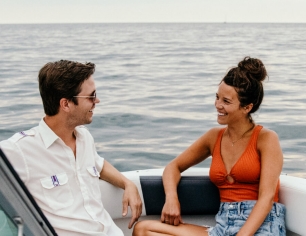What are the three main types of boats?
Boats can be categorized in several ways, but the three main types are sailboats, powerboats, and human-powered boats. Sailboats are powered by the wind and are often used recreationally or for long- distance travel. Motorboats, also known as power boats, are engine-powered and typically used for leisure activities such as water sports and fishing. Human-powered boats rely on manual effort for movement and have a wide range of uses.
Explore Progressive's editorial standards for Answers articles to find out why you can trust the insurance information you find here.
Types of sailboats
There are various types of sailboats, each designed for specific purposes, water conditions, and sailing styles. They can be classified by their hull type, which refers to the shape and structure of the boat's bottom portion. Here are some of the most popular types:
- Sloop: The most popular sailboat type, sloops are versatile and have a single mast and two sails—a mainsail and a headsail -- ideal for beginners
- Catamaran: This style has a wide construction of two small hulls joined by a deck, which gives more deck and cabin space and rides higher in the water
- Trimaran: Like a catamaran but with three hulls (hence the name), they’re like catamarans but faster and more stable
- Cutter: With an additional headsail, the cutter offers more sail plan flexibility, especially in heavy winds, making it a favorite for long-distance cruisers
- Ketch: A ketch has two masts: a mainmast and a shorter mizzen mast located aft of the mainmast but forward of the rudder, allowing for more manageable sails
- Yawl: Like a ketch, but the shorter mast is behind the rudder post, which makes for easy handling
Types of powerboats
These boats come in various sizes and styles and are used for multiple activities. Common types of powerboats include:
- Bowrider: Open, versatile, and sporty vessels with seating in the bow and wide, flat bottoms making it ideal for families and activity outings
- Cabin cruiser: A medium-sized powerboat equipped with sleeping accommodations, a galley, and a head (bathroom)—ideal for overnight trips and extended cruising
- Center console: Features a helm station located in the center of the boat, allowing for easy movement around the entire deck—perfect for fishing and water sports
- Trawler: Similar to motor yachts, but with a different hull design that trades speed for greater stability and comfort
- Pontoon: Consists of a platform fixed to two or more buoyant metal tubes, which provides stability for leisure activities on calm waters
- PWC (personal watercraft): Commonly known by brand names like Jet Ski or Sea-Doo, PWCs are small and are waterjet propelled, offering motorcycle-like thrills on the water
- Ski/Wakeboard: Specifically designed to create the perfect conditions for watersports like skiing and wakeboarding
Types of human powered boats
Propelled by human effort, typically using paddles, oars, pedals, or poles instead of engines or sails, these small boats are often used for recreation. Here are some popular small boats people can power:
- Dinghy: Generally used as a tender for larger vessels, a dinghy can be propelled by a sail, small motor, or oars
- Kayak: A narrow boat propelled by a double-bladed paddle, often used on lakes, rivers, or in the ocean
- Canoe: Another small boat that is slightly wider than a kayak and uses a single-bladed paddle
- Jon boat: A flat-bottomed, shallow water boat with bench seats, popular for fishing on lakes and ponds
- Skiff: A flat-bottomed small boat moved by oars, a sail, or outboard motor, often used as a tender or for fishing
- Rowboats: Propelled by oars and frequently used for fishing and leisure activities
Stay protected on the water
Boat insurance can protect you and your vessel and is typically required if you finance your boat. If you dock at a marina, they may also require proof of insurance. Find out what boat insurance covers and how boat insurance works.
What's the difference between aluminum and fiberglass boats?
The main difference between aluminum and fiberglass boats is the material they're constructed from, which affects a boat's durability, weight, maintenance, and performance. If you're going solo, aluminum boats are lighter and easier to handle. If you're taking family and friends out on the water, a heavier fiberglass boat may be better. Find out the pros and cons of aluminum and fiberglass boats.
What are the best boats for lakes?
The size of the lake and your choice of recreational activities determines the size and type of boat that suits your needs. If you're spending time on big lakes with deep water, you might choose a boat that you could also use in the ocean like a cabin cruiser or center console. If you spend most of your recreational time at smaller, shallow lakes, you may do better with a pontoon. Options for the best boats for lakes typically include:
- Sailboats
- Towboats
- Day cruisers
- Pontoon boats
If you have a family, or if you entertain groups of friends, you might consider a boat with overnight accommodations on larger lakes, like an express cruiser.
Which boats are suitable for the ocean?
In general, ocean-going vessels are larger and provide more stability for handling choppy waves and deep water. Good options for saltwater boats include:
- Sailboats
- Cabin cruisers
- Express cruisers
- Motor yachts
- Trawlers
- Center consoles
Protect your boat with Progressive

Online
We'll ask easy questions about you and your boat, then you can choose coverages.
Get a boat insurance quote online
Call a rep
You'll speak with a licensed representative who will guide you through everything.
Call 1-866-749-7436
Through an agent
If you want local advice, we'll connect you with a licensed independent agent near you.
Find an agent online
Enjoy life on the water with boat insurance from Progressive
Learn more about our boat insurance offering.









